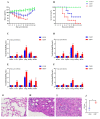Pathogenicity and Transmissibility of Goose-Origin H5N6 Avian Influenza Virus Clade 2.3.4.4h in Mammals
- PMID: 36366552
- PMCID: PMC9699601
- DOI: 10.3390/v14112454
Pathogenicity and Transmissibility of Goose-Origin H5N6 Avian Influenza Virus Clade 2.3.4.4h in Mammals
Abstract
Throughout the last decade, H5N6 avian influenza viruses (AIVs) circulating in poultry and infecting humans have caused increasing global concerns that they might become a pandemic threat to global health. Since AIVs could occasionally cause asymptomatic infections in geese, virus monitoring in such a host should be critical to the control of cross-species infection. In addition, previous studies showed that clade 2.3.4.4h H5N6 AIVs could infect mammals without adaptation. However, the pathogenicity and transmissibility of goose-origin clade 2.3.4.4h H5N6 AIVs in mammals remain unknown. In this study, two H5N6 AIVs were isolated from a domestic chicken (A/chicken/Hebei CK05/2019 (H5N6)) and a goose (A/goose/Hebei/GD07/2019(H5N6)). This study is the first to evaluate the pathogenicity and transmissibility of goose-origin clade 2.3.4.4h H5N6 AIVs in mammals by comparison with chicken-origin 2.3.4.4h H5N6 AIVs. The CK05 virus had an affinity for α-2,3-receptors, while the GD07 virus had an affinity for both α-2,3-and α-2,6-receptors. The GD07 virus had a higher replication capacity in vitro and more severe pathogenicity in mice than the CK05 virus. The CK05 virus could not be transmitted effectively among guinea pigs, whereas the GD07 virus could be transmitted through direct contact among guinea pigs. The results of this study indicated the potential health threat of clade 2.3.4.4h H5N6 AIVs to mammals and emphasized the importance of continuous monitoring of H5N6 AIVs, especially in waterfowl.
Keywords: H5N6; chicken; goose; pathogenicity; transmissibility.
Conflict of interest statement
The authors declare no conflict of interest.
Figures





Similar articles
-
Pathogenicity and Transmissibility of Clade 2.3.4.4h H5N6 Avian Influenza Viruses in Mammals.Animals (Basel). 2022 Nov 9;12(22):3079. doi: 10.3390/ani12223079. Animals (Basel). 2022. PMID: 36428307 Free PMC article.
-
Different Pathogenicity and Transmissibility of Goose-Origin H5N6 Avian Influenza Viruses in Chickens.Viruses. 2019 Jul 4;11(7):612. doi: 10.3390/v11070612. Viruses. 2019. PMID: 31277451 Free PMC article.
-
Pathogenicity and transmissibility of a highly pathogenic avian influenza virus H5N6 isolated from a domestic goose in Southern China.Vet Microbiol. 2017 Dec;212:16-21. doi: 10.1016/j.vetmic.2017.10.022. Epub 2017 Nov 2. Vet Microbiol. 2017. PMID: 29173583
-
Pathogenicity and transmissibility of clade 2.3.4.4 highly pathogenic avian influenza virus subtype H5N6 in pigeons.Vet Microbiol. 2020 Aug;247:108776. doi: 10.1016/j.vetmic.2020.108776. Epub 2020 Jun 22. Vet Microbiol. 2020. PMID: 32768222
-
Evolution, global spread, and pathogenicity of highly pathogenic avian influenza H5Nx clade 2.3.4.4.J Vet Sci. 2017 Aug 31;18(S1):269-280. doi: 10.4142/jvs.2017.18.S1.269. J Vet Sci. 2017. PMID: 28859267 Free PMC article. Review.
Cited by
-
Phylodynamics and Molecular Mutations of the Hemagglutinin Affecting Global Transmission and Host Adaptation of H5Nx Viruses.Transbound Emerg Dis. 2023 Apr 14;2023:8855164. doi: 10.1155/2023/8855164. eCollection 2023. Transbound Emerg Dis. 2023. PMID: 40303705 Free PMC article.
References
-
- Pantin-Jackwood M.J., Costa-Hurtado M., Bertran K., DeJesus E., Smith D., Swayne D.E. Infectivity, transmission and pathogenicity of H5 highly pathogenic avian influenza clade 2.3.4.4 (H5N8 and H5N2) United States index viruses in Pekin ducks and Chinese geese. Vet. Res. 2017;48:33. doi: 10.1186/s13567-017-0435-4. - DOI - PMC - PubMed
Publication types
MeSH terms
LinkOut - more resources
Full Text Sources
Medical

